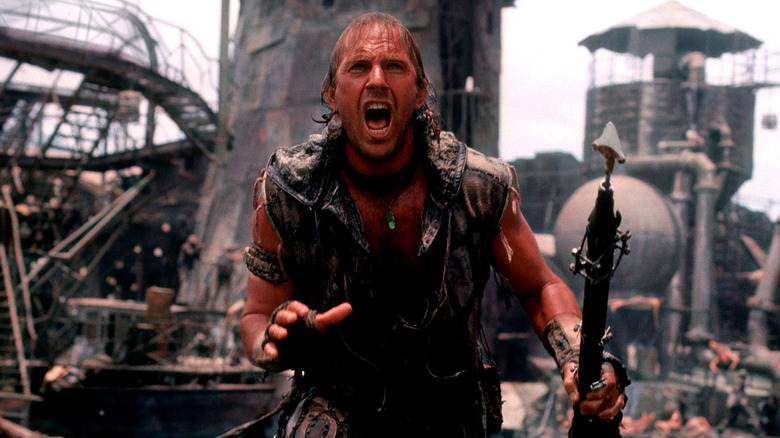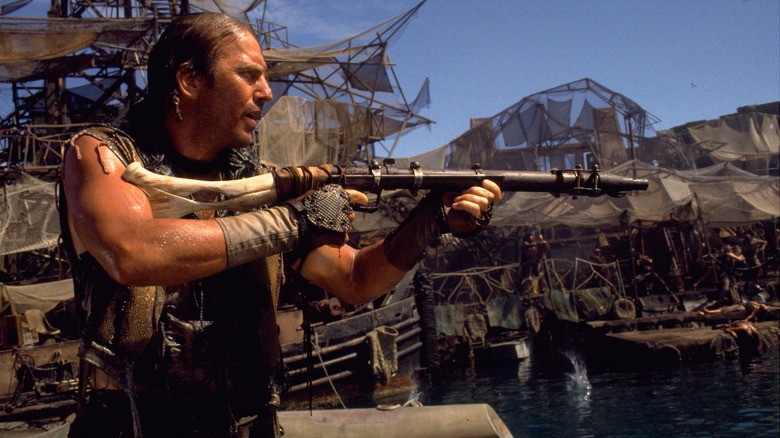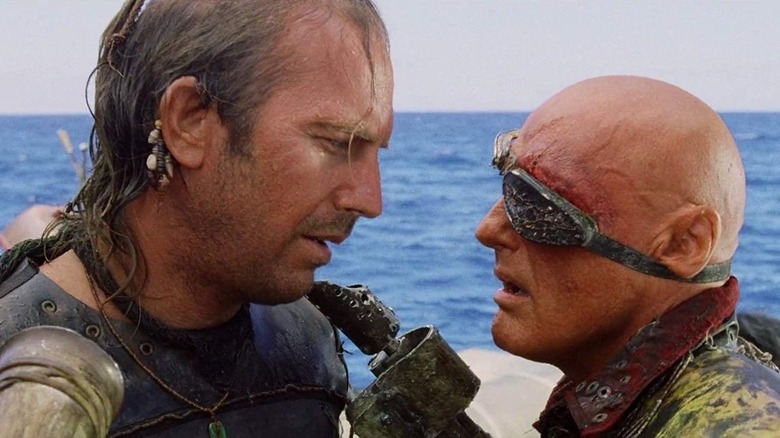The Wildest Things That Happened On The Set Of Waterworld
Kevin Reynolds' 1995 film "Waterworld" was, at the time of its release, the most expensive movie ever made. Thanks to a slew of production problems (not least of which was a floating set that persistently sank) the movie's budget ballooned, ultimately costing Universal Pictures about $172 million. Adjusted for inflation, that's about $306 million. It would be only two years later that James Cameron's "Titanic" would be released, surpassing "Waterworld" in terms of budget; "Titanic" cost, when adjusted, about $338 million. Since then, only five films have cost more than "Titanic." Three of them have the word "Avengers" in the title. The other two have the word "Pirates."
The production problems on "Waterworld" were well-publicized, and attentive readers of the Los Angeles Times were following the expansion of the film's cost from an already expensive $100 million to $135 million and beyond. Words like "chaos" and "difficult" and "out of control" began leaking from the set. One anonymous crew member pointed out that no one was in charge. It certainly didn't help that "Waterworld" was buffeted by inclement weather. The Washington Post mockingly nicknamed the film "Fishtar" after Elaine May's notorious 1987 bomb "Ishtar," and others took to calling it "Kevin's Gate," after Michael Cimino's even more notorious 1980 turkey "Heaven's Gate."
When it finally came time for the film's release, "Waterworld" was a neatly pre-packaged fiasco, ready to fail. Many young people at the time attended "Waterworld" just to witness what a film that expensive might look like. That "Waterworld" ended up being a mild success was a relief all around.
The polar ice caps have melted
The premise for "Waterworld" was cleanly explained in a striking trailer. Narrator James Earl Jones explains in voiceover that, thanks to climate change, the Earth's polar ice caps have melted, causing water levels to rise all over the world, swallowing any semblance of dry land. Humanity, during the cataclysm, moved onto ramshackle floating sea forts, derelict oil tankers, and homemade catamarans. By A.D. 2500, humans have pretty much forgotten that land ever existed, and the world is essentially a post-apocalyptic wasteland akin to George Miller's "The Road Warrior," only at sea.
Kevin Costner plays a mysterious drifter called simply The Mariner who has a mysterious pot of dirt (a rare commodity indeed) as well as a set of rudimentary gills. It's only been a few centuries, but humanity is already evolving. Waterworld is also populated by a tribe of evil pirates called Smokers — so named for their cigarette habit — led by Dennis Hopper.
"Waterworld" was going to be filmed entirely at sea, an idea that no one less than Steven Spielberg discouraged. Shooting on water is difficult, and the location led to multiple expensive disasters.
For one, the multimillion dollar set, built in an enormous offshore tank off the coast of Hawaii, was hit by a hurricane during productions, leading to the entire thing sinking to the bottom and requiring a second one to be built. The cost of the sinking set led to Costner investing $22 million of his own personal cash into the production. The sunken set also ended up preventing certain scenes from being filmed, and 30 pages ended up being cut from the script. Common wisdom dictates that to have potentially been 30 minutes of screen time.
But despite his own financial commitment, Costner didn't make things easy on the production.
The high Costner of living
Costner's ego was, reportedly (according to the Fail Blog on Cheezburger.com), a little out of control on "Waterworld," which slowed production down considerably. There were rumors that Costner, who was experiencing male pattern baldness in 1994, asked the film's SFX department to go in with computers and digitally add hair. These rumors are unsubstantiated, but were weirdly believable given other stories from the set. Evidently, Costner, a producer on the film, wanted either Robert Zemeckis or Lawrence Kasdan to direct. When neither of them was interested, he asked for Kevin Reynolds specifically.
Despite being personally selected, Reynolds and Costner fought endlessly on the set. Costner, unhappy with what Reynolds had shot, ended up serving as an uncredited editor on "Waterworld." Reynolds had evidently shot a three-hour version of "Waterworld," but the theatrical cut was a mere 135 minutes.
There was another strange local financial problems. Food and shelter were provided by local Hawaiian businesses, and they evidently wildly overcharged the production. Costner himself stayed in a local waterfront villa that charged $4,500 a night. This was after the film's production schedule had been expanded from an already-lengthy 90 days to 200 days, which works out at $900,000 just for the star's accommodation. Costner, at the very least, was committed. He ended up on set for 157 days of the 200 day schedule, only taking Sundays off.
O jellyfish, where is thy sting?
Famed professional surfer Laird Hamilton, featured in Stacey Peralta's 2004 documentary film "Riding Giants," appeared in "Waterworld" as The Mariner's stunt double. Laird would commute to work on a jetski, and did a lot of diving, swimming, and operation of the Mariner's signature trimaran. Relentless bad weather made operation of the trimaran — as well as simply being on set — a constant danger. Costner had already almost died during a sudden squall, and Laird was also once ripped out to sea on it. Laird also reported being stung several times by jellyfish during production.
Another issue that no one had seemed to think about during production was the issue of lavatories. None of the boats nor the expensive "atoll" set were equipped with toilets, and regular bathroom breaks needed to be scheduled for actors and crew to be transported to a nearby ship.
Despite all of its production problems and horrible reputation, "Waterworld" ultimately made its money back. It was adapted into comic books, Nintendo games, and a rather fun pinball machine. The film's most lasting legacy is the "Waterworld" stunt spectacular at Universal Studios Hollywood, Japan, Singapore, and Beijing. The stunt show initially opened in Hollywood in October 1995, a few months after the film's release. Although the movie was considered a fiasco, the live stunt show was a hit, and continues to run in Hollywood to this day.


